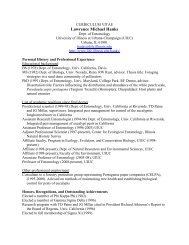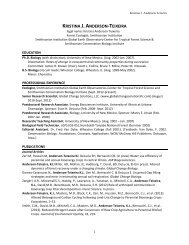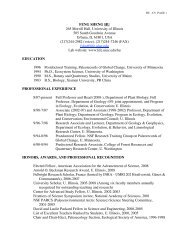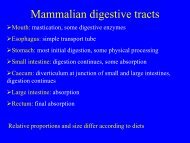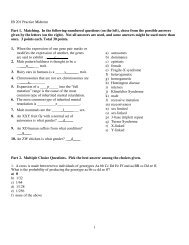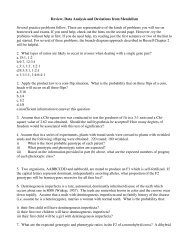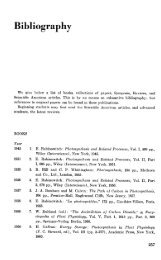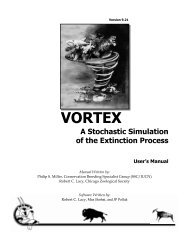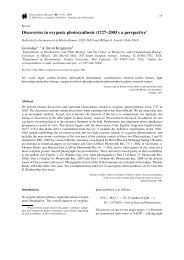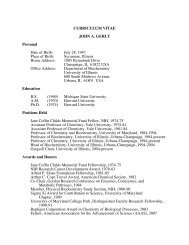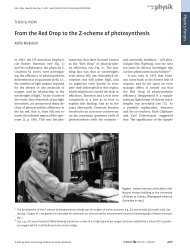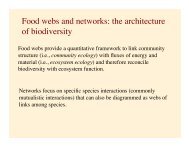Lecture 8 - Reproduction 2
Lecture 8 - Reproduction 2
Lecture 8 - Reproduction 2
You also want an ePaper? Increase the reach of your titles
YUMPU automatically turns print PDFs into web optimized ePapers that Google loves.
Mammalian reproduction 2: short-term<br />
(hormonal) cycles and general patterns<br />
1. Estrus cycles<br />
2. Flexible kangaroos<br />
3. Semelparity and iteroparity<br />
4. Examples of iteroparity<br />
5. Income and capital breeders
Eutherian estrous cycle<br />
Proestrus: beginning stage, transition from anestrus to estrus<br />
Estrus: peak estrogen production and ovulation<br />
Metestrus: estrogen declines, progesterone increases, implantation<br />
occurs. If successful, gestation follows.<br />
Diestrus: if no implantation, progesterone declines, corpus luteum<br />
regresses (still metestrus), then short period (diestrus) occurs before<br />
start of next cycle<br />
*FSH = follicle stimulating hormone, LH = luteinizing hormone
Stuff you don’t need to memorize, but I’ll review quickly… see Ch 20!<br />
Pituitary secretes FSH, ovarian follicle in turn produces<br />
estrogen. Peak estrogen = ovulation (“heat”).<br />
Ovulation can be induced (rabbits, many carnivores,<br />
some rodents) or spontaneous (most mammals).<br />
Ruptured follicle forms corpus luteum, glandular<br />
structure that contributes progesterone, which<br />
sensitizes uterus for implantation. Placenta later takes<br />
over as major producer of progesterone.<br />
Abrupt drop in progesterone and switch to production of<br />
prolactin (stimulates mammary development), plus<br />
spike in oxytocin leads to parturition.
Metatherian estrous cycle<br />
Differences:<br />
Implantation occurs later, near peak progesterone (remember, first<br />
2/3 w/shell membrane).<br />
Lactation stops cycle (parturition occurs before next cycle would start<br />
in most species).<br />
If gestation > estrous cycle (some kangaroos), new ovulation can<br />
occur, followed by mating. Fertilized egg goes dormant = diapause.
Record for longest gestation: 22 months<br />
(shortest is a bandicoot, 12 days)
1 st cycle: kangaroo<br />
Assembly line production<br />
in kangaroos!
Milk composition also varies over time. Different mammary glands<br />
can be producing different kinds of milk for different young!
Even in placentals<br />
(e.g., lab rat)<br />
Lengths of various events can<br />
vary with energy demands
Menstrual cycle<br />
Final variation: old world monkeys, apes, humans, similar pattern in<br />
tree shrews and elephant shrews. Estrogen maintained at higher<br />
levels than typical, P and E crash abruptly if no pregnancy,<br />
endometrial lining of uterus sloughs off along with some bleeding<br />
during first part of next proestrus.
Male cycles<br />
Mostly controlled by testosterone. Production can<br />
respond to photoperiod, temperature, nutrition (more<br />
later).<br />
In rodents and some others (e.g., bats) testes and<br />
associated glands grow and regress seasonally, may<br />
change location from abdominal to scrotal.<br />
Behavior, characteristics like antler growth, affected.
Semelparity vs iteroparity<br />
Semelparous: only 1 reproductive period per lifetime<br />
Iteroparous: multiple reproductive events per lifetime<br />
Semelparity is very unusual for mammals, but....
The Amazing Antechinus!<br />
•Small marsupial<br />
•All females give birth within a few<br />
days each year (synchrony; Oct =<br />
Australian spring)<br />
•In late Sept, shortly after females<br />
mate, all males die!<br />
•Males go into hormonal overdrive, turn all energy into breeding<br />
activities, form aggregations that are visited by females. After 3<br />
weeks of this, males stressed out, gastrointestinal ulcers, hair loss,<br />
stress-induced diseases... Die!<br />
•Females only receptive during mating period, can store sperm and<br />
only ovulate at end of mating period; get pregnant and give birth after<br />
all males in population are dead. (males live 1 yr, females mostly 1,<br />
2, very rarely 3)
Most mammals are iteroparous, but iteroparity can<br />
vary:<br />
•Monestrous: 1 reproductive event per year.<br />
Examples: large mammal with long gestation period, such as whitetailed<br />
deer, but also hibernators, such as ground squirrels. Iteroparous,<br />
but over multiple years.<br />
•Polyestrous: many estrus cycles (ovulations) per year. Many rodents<br />
and shrews can be continuously active throughout their life. Some are<br />
opportunistic and can breed almost any month of the year if weather and<br />
resources permit.<br />
•Seasonally polyestrous: multiple estrus cycles, but within limited times<br />
of year. Examples are many small mammals that are iteroparous within<br />
a breeding season but not reproductive all year.
An example: red foxes<br />
•Monestrous<br />
•Females come into estrous<br />
during late Jan to early Feb,<br />
for a short period of 3-4 days.<br />
Females within a population<br />
are relatively synchronous.<br />
(probably to keep those mates<br />
honest!)<br />
•Males are reproductively capable (= active spermatogenesis) for a<br />
longer time, around Dec through March or so, that encompasses the<br />
time of female receptivity (probably to be available for any<br />
opportunities!)<br />
•Gest = about 51 d. Mating in winter assures young will be born in<br />
late March or April, right at start of “good” season.
Illustration of text on previous page…<br />
Lines just show “reproductive activity,” no<br />
particular levels of anything
Other species, such as ground squirrels, have short enough<br />
gestation periods that they can wait until the start of spring to<br />
initiate reproduction.<br />
•Hibernators (7-8.5 months per year)<br />
•Males emerge 1 st , mid-April, about 2<br />
weeks before females in early May<br />
•Breeding occurs after females<br />
emerge, gest = 26-28 d, young born<br />
by late May to early June<br />
13-lined<br />
•Only time for 1 litter per year, so still<br />
monestrous<br />
(why can’t hibernating ground<br />
squirrels go for a second litter like tree<br />
squirrels?)<br />
Franklin’s
<strong>Reproduction</strong> can be limited to part of the year, but<br />
gestation and lactation may be short enough to allow<br />
more than one litter.<br />
Not always just due to cold. Tropics can have wet<br />
and dry seasons that affect resource availability.<br />
Most small mammals show some form of seasonal<br />
polyestry (example: gray and fox squirrels in IL)
Reproductive patterns of gray and fox<br />
squirrels in Illinois<br />
If 2 litters per year, 1 in spring and 1 in late summer. Litter size<br />
usually 2-3. Lifespan: gray up to 6 yrs, fox around 7 years.
Capital vs Income Breeders<br />
Capital breeder: accumulate energy reserves for breeding<br />
Income breeder: relies on high metabolic rate, ability to<br />
obtain and process energy currently available in<br />
environment for reproduction<br />
Harbor seal: accumulates fat to<br />
help support annual, intense<br />
lactation period; predictable<br />
White-footed mouse: litter size<br />
and reproduction adjusted to<br />
environmental conditions;<br />
opportunistic
Degree of newborn development<br />
Altricial young:<br />
rodents, rabbits,<br />
insectivores,<br />
carnivores like<br />
canids and bears<br />
Precocial young:<br />
ungulates, whales,<br />
most primates<br />
What are pros and<br />
cons of these two<br />
approaches?
Precocial young typically require longer gestation<br />
periods.<br />
Precocial young also typically come in smaller litters,<br />
often singles, since each offspring must come to a<br />
relatively advanced stage (and sometimes large size)<br />
by birth.<br />
Smaller investment in individual offspring by birth in<br />
altricial young.<br />
Not strictly conservative phylogenetically (e.g., rabbits<br />
vs hares; guinea pigs fairly precocial; humans vs other<br />
apes; bears vs other carnivorans).
Polyembryony in 9-banded armadillo<br />
4 genetically identical<br />
siblings from same<br />
placenta
Study questions:<br />
1. Why might the marsupial mode of reproduction be<br />
advantageous under some conditions?<br />
2. Be able to define and give a mammalian example of:<br />
Monestrous, polyestrous, seasonally polyestrous reproduction<br />
Semelparous, iteroparous reproduction<br />
Capital breeder, income breeder<br />
3. How does a successful pregnancy and lactation affect the<br />
next sequential pregnancy in a kangaroo? Lab rat?



